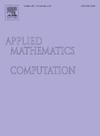用切比雪夫谱投影法求得超积分第一类积分方程的超收敛结果
IF 3.5
2区 数学
Q1 MATHEMATICS, APPLIED
引用次数: 0
摘要
在本文中,我们提出了切比雪夫谱投影法来求解第一类超正交积分方程。由于积分方程的第一部分存在哈达玛意义上的强奇异性,因此获得超收敛结果具有挑战性。为了克服这一问题,我们将第一类超奇异积分方程转化为第二类积分方程。这是通过在某个合适的希尔伯特空间定义超积分算子的有界逆来实现的。在等效的第二类积分方程上使用迭代切比雪夫谱 Galerkin 方法,我们获得了 O(N-2r)的改进收敛性,其中 N 是近似空间中使用的切比雪夫多项式的最高度数,r 是解的平滑度。此外,利用投影算子的交换性和超积分算子的逆,我们可以通过切比雪夫谱多伽勒金方法(CSMGM)和迭代 CSMGM 分别获得 O(N-3r) 和 O(N-4r) 的超收敛性。最后,我们给出了数值实例来验证我们的理论结果。本文章由计算机程序翻译,如有差异,请以英文原文为准。
Superconvergence results for hypersingular integral equation of first kind by Chebyshev spectral projection methods
In this article, we propose Chebyshev spectral projection methods to solve the hypersingular integral equation of first kind. The presence of strong singularity in Hadamard sense in the first part of the integral equation makes it challenging to get superconvergence results. To overcome this, we transform the first kind hypersingular integral equation into a second kind integral equation. This is achieved by defining a bounded inverse of the hypersingular integral operator in some suitable Hilbert space. Using iterated Chebyshev spectral Galerkin method on the equivalent second kind integral equation, we obtain improved convergence of , where is the highest degree of Chebyshev polynomials employed in the approximation space and r is the smoothness of the solution. Further, using commutativity of projection operator and inverse of the hypersingular integral operator, we are able to obtain superconvergence of and , by Chebyshev spectral multi-Galerkin method (CSMGM) and iterated CSMGM, respectively. Finally, numerical examples are presented to verify our theoretical results.
求助全文
通过发布文献求助,成功后即可免费获取论文全文。
去求助
来源期刊
CiteScore
7.90
自引率
10.00%
发文量
755
审稿时长
36 days
期刊介绍:
Applied Mathematics and Computation addresses work at the interface between applied mathematics, numerical computation, and applications of systems – oriented ideas to the physical, biological, social, and behavioral sciences, and emphasizes papers of a computational nature focusing on new algorithms, their analysis and numerical results.
In addition to presenting research papers, Applied Mathematics and Computation publishes review articles and single–topics issues.

 求助内容:
求助内容: 应助结果提醒方式:
应助结果提醒方式:


